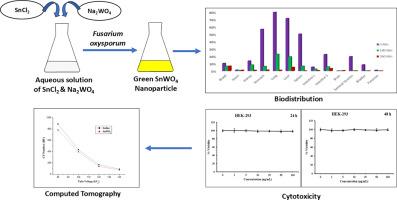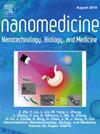Highly fluorescent sustainable SnWO4 nanoparticles as contrast agent for computed tomography (CT)
IF 4.6
2区 医学
Q2 MEDICINE, RESEARCH & EXPERIMENTAL
Nanomedicine : nanotechnology, biology, and medicine
Pub Date : 2025-09-22
DOI:10.1016/j.nano.2025.102859
引用次数: 0
Abstract
X-ray computed tomography (CT) is extensively used in medicine and research, often requiring iodine-based contrast agents which can cause adverse effects in iodine-intolerant patients. Considering safer alternatives, we have biosynthesized and comprehensively characterized highly fluorescent tin tungstate nanoparticles (SnWO₄ NPs) with a size of 40 nm, and compared their effectiveness as contrast agents in CT imaging with that of the commercially available OMNIPAQUETM Iohexol injection. The comparative analysis at 80 kVp showed that the highest CT numbers at 10 mg/ml were 2106 ± 101 for iodine and 1477 ± 40 for SnWO₄ NPs, while the lowest at 1 mg/ml were 63 ± 10 and 45 ± 13, respectively. The in vitro cytotoxicity of SnWO₄ NPs against HEK-293 cells, splenocytes, and thymocytes together with their biodistribution in healthy Wistar rats was evaluated revealing minimal toxicity. These findings indicate that SnWO₄ NPs hold significant promise for biomedical imaging applications, demonstrating excellent contrast performance and positioning them as strong candidates for future use as contrast agents.

高荧光可持续的snowo4纳米颗粒作为计算机断层扫描(CT)的造影剂。
x射线计算机断层扫描(CT)广泛应用于医学和研究,通常需要碘基造影剂,这可能对碘不耐受患者造成不良影响。考虑到更安全的替代品,我们生物合成并全面表征了尺寸为40 nm的高荧光钨酸锡纳米颗粒(SnWO₄NPs),并将其作为CT成像造影剂的有效性与市售的OMNIPAQUE碘己醇注射剂进行了比较。在80 kVp下对比分析发现,在10 mg/ml时,碘的CT数最高为2106 ± 101,SnWO₄NPs的CT数最高为1477 ± 40,而在1 mg/ml时,最低的CT数分别为63 ± 10和45 ± 13。通过对SnWO₄NPs对HEK-293细胞的体外细胞毒性及其在健康Wistar大鼠体内的生物分布进行评估,发现其毒性最小。这些发现表明,SnWO₄NPs在生物医学成像应用中具有重要的前景,表现出优异的对比性能,并将其定位为未来用作对比剂的强有力的候选者。
本文章由计算机程序翻译,如有差异,请以英文原文为准。
求助全文
约1分钟内获得全文
求助全文
来源期刊
CiteScore
11.10
自引率
0.00%
发文量
133
审稿时长
42 days
期刊介绍:
The mission of Nanomedicine: Nanotechnology, Biology, and Medicine (Nanomedicine: NBM) is to promote the emerging interdisciplinary field of nanomedicine.
Nanomedicine: NBM is an international, peer-reviewed journal presenting novel, significant, and interdisciplinary theoretical and experimental results related to nanoscience and nanotechnology in the life and health sciences. Content includes basic, translational, and clinical research addressing diagnosis, treatment, monitoring, prediction, and prevention of diseases.

 求助内容:
求助内容: 应助结果提醒方式:
应助结果提醒方式:


